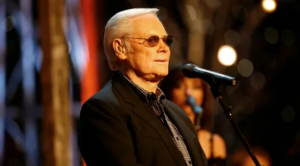
In the realm of country music, where heartfelt narratives and authentic expressions reign supreme, few voices resonate as profoundly as that of George Jones. Renowned as the “Possum,” Jones’s distinctive baritone, imbued with a raw emotional intensity, has captivated audiences for decades. His ability to convey the complexities of the human experience, particularly the trials and tribulations of love and life, has solidified his status as one of the genre’s most iconic and influential figures. Among his vast repertoire of timeless classics, “I’m Ragged but I’m Right” stands as a testament to Jones’s enduring artistry, a poignant exploration of resilience, self-worth, and the unwavering pursuit of one’s convictions.
Background
Released in 1962 as the B-side to the chart-topping single “White Lightning,” “I’m Ragged but I’m Right” quickly garnered critical acclaim and resonated deeply with listeners. Penned by veteran songwriters Harlan Howard and Buck Owens, the song paints a vivid portrait of a man who, despite facing adversity and hardship, refuses to compromise his integrity. Jones’s emotive delivery brings the lyrics to life, imbuing them with a sense of authenticity and vulnerability that resonates with audiences across generations.
The song’s introspective narrative unfolds with a contemplative pace, allowing Jones’s rich baritone to set the stage for the lyrical exploration that follows. The opening lines, “Well, I may be ragged, but I’m right,” immediately establish the central theme of the song, a declaration of self-worth in the face of external judgment. Jones’s voice conveys a sense of quiet determination, as if he is addressing a silent critic, asserting his unwavering belief in his own righteousness.
The subsequent verses delve deeper into the protagonist’s experiences, painting a picture of a life marked by struggle and disappointment. Jones sings of losing his job, his home, and his love, yet he refuses to succumb to despair. Instead, he clings to his principles, his unwavering belief in what is right, even as the world around him crumbles. The imagery is stark and evocative, resonating with listeners who have faced their own personal challenges.
The chorus serves as a powerful affirmation of the protagonist’s resilience. “I may be ragged, but I’m right” is repeated with unwavering conviction, a defiant declaration of self-worth in the face of adversity. Jones’s voice soars with emotion, conveying a sense of triumph and vindication. It is a moment of catharsis, a release of the pent-up frustration and pain that the protagonist has endured.
The bridge of the song introduces a note of introspection, as the protagonist contemplates the choices he has made and the path that has led him to this point. He acknowledges that his life has not been easy, but he also affirms that he has remained true to himself. The lyrics are filled with regret and longing, but they also convey a sense of acceptance and resignation.
The final verse brings the song to a poignant conclusion, as the protagonist reflects on his journey and reaffirms his unwavering belief in himself. He may be “ragged,” but he is “right,” and he will continue to fight for what he believes in, no matter the cost. The song ends with a sense of hope and determination, a reminder that even in the darkest of times, it is possible to find strength and resilience within oneself.
Video
“I’m Ragged but I’m Right” is a masterpiece of country songwriting, a timeless exploration of human resilience and the unwavering pursuit of one’s convictions. George Jones’s masterful performance brings the song to life, imbuing it with a raw emotional intensity that resonates with listeners across generations. The song’s introspective narrative, evocative imagery, and powerful chorus make it a poignant and enduring anthem of self-worth and determination.